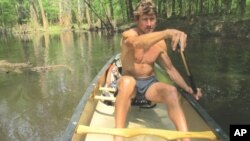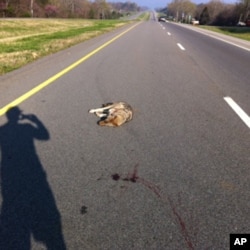John Davis is on a campaign to save American wildlife. The writer and conservationist is biking, paddling, hiking and boating his way north from the Florida Keys to Quebec to promote a connected, protected wildlife corridor that’s safe for animals.
Davis is mid-way through the 7,000-kilometer TrekEast, which began in March. His travels have taken him along back country trails, into streams and rivers and through forests and meadows.
“We have bears and red wolves in a couple of places. We have panthers in Florida. We have a songbird population throughout the forested parts of eastern United States and an abundance of reptiles and amphibians that matches almost any region of the world.”
Davis sees problems first hand. Urban sprawl and poor farming and forest practices have destroyed habitat and isolated and in some cases decimated animal communities. Despite these threats, he remains optimistic that a wildway is possible, even in the densely populated mid-Atlantic region near Washington, where he's passing through.
Davis has taken a city-break in Washington a few days bike ride from the highlands of West Virginia, an area that's has been proposed for a new national park. “It’s an example of a place that still has most of its native species, but it’s missing the top predators, the panthers and the wolves and it really needs them back,” he says.
Davis takes that message to the National Parks Conservation Association, an advocacy group for animals and wild places. He’s confident that missing predators could return with federal government help, he tells the group.One staffer laments how the landscape has changed.
Davis agrees and describes the impact of the growing deer population in American forests and meadows. “The understory is basically gone. You look for miles to find a wild flower and deer are everywhere,” he says.
Davis says he sees a lot of road kill on the highways. "New underpasses and overpasses could keep animals safe," he says.
Davis also recommends government incentives to encourage farmers, ranchers and private landholders to keep their land wild.
“If we are to achieve an eastern wildway, this system of connected, protected wildlife habitats, it’s going to take a whole network of people and groups cooperating together. It’s going to take an understanding on the part of the American people that we want to save our natural heritage, and it’s not too late to do so,” he says.
His ideas get a welcome hearing at Island Press, another stop in Washington. Staffers with this environmental publishing group are waiting to join Davis on a bike ride around the city. As they pedal past the U.S. Capitol, assistant editor Courtney Lix acknowledges that it will take political will to put a wildway in place.
But she says she has no doubt that one committed person can change the world. “We all have to find those issues that we care very much about and speak out about them. And when you have the kind of passion that John does, it is going to resonate with other people.”
Davis continues his trek north with the hope that his mission to save native species and healthy habitats takes root. By November, he’ll reach the tip of Quebec’s Gaspe Peninsula. In the meantime Davis invites you to tag along online at wildlandsnetwork.org.











